promoting gender equitable opportunities in agricultural ... - weman
promoting gender equitable opportunities in agricultural ... - weman
promoting gender equitable opportunities in agricultural ... - weman
You also want an ePaper? Increase the reach of your titles
YUMPU automatically turns print PDFs into web optimized ePapers that Google loves.
PHASE FOUR: TAKING ACTIONS TOREMOVE GENDER-BASED CONSTRAINTSAfter determ<strong>in</strong><strong>in</strong>g the most critical GbCs to address, Phase Four focuses on bra<strong>in</strong>storm<strong>in</strong>g possible actions toremove these constra<strong>in</strong>ts and take advantage of <strong>opportunities</strong> to support women’s economic empowerment.This is an iterative and creative process that encourages practitioners to th<strong>in</strong>k <strong>in</strong>novatively and to evaluate thedifferent <strong>opportunities</strong> of action aga<strong>in</strong>st the economic and social realities of the program and its objectives. Thetemptation may be to th<strong>in</strong>k conservatively about the possible actions. A fear of “chang<strong>in</strong>g culture” often casts ashadow on bra<strong>in</strong>storm<strong>in</strong>g efforts, but practitioners should consider all possible actions and then determ<strong>in</strong>e howthey can be appropriately implemented <strong>in</strong> the specific socioeconomic context.Address<strong>in</strong>g <strong>gender</strong> issues <strong>in</strong> value cha<strong>in</strong>s seeks to identify relationships and actions that enhance value cha<strong>in</strong>efficiency and competitiveness while support<strong>in</strong>g <strong>gender</strong> equality goals. This makes it possible for USAID-fundedprograms to meet the dual objectives of achiev<strong>in</strong>g programmatic targets, as well as support<strong>in</strong>g USAID policy on<strong>gender</strong> <strong>in</strong>tegration. In this way, it identifies leverage po<strong>in</strong>ts at which value cha<strong>in</strong> <strong>in</strong>terventions generate positive<strong>gender</strong> outcomes or <strong>gender</strong> <strong>in</strong>terventions generate broader positive value cha<strong>in</strong> outcomes.Cascad<strong>in</strong>g factors refer to situations <strong>in</strong> which multiple factors build on one another to create <strong>gender</strong> <strong>in</strong>equalities. Forexample, women’s lack of f<strong>in</strong>ance may be the result of their lack of access to collateral such as land. Women’s lack ofaccess to land may be the product of <strong>in</strong>heritance practices or legal <strong>in</strong>stitutions that do not grant them the right to land.Address<strong>in</strong>g the <strong>gender</strong>-based constra<strong>in</strong>t therefore can happen at multiple levels or at levels with<strong>in</strong> the manageable <strong>in</strong>terestsof the project.Step 1. Take stock of <strong>gender</strong>-based constra<strong>in</strong>ts.Hav<strong>in</strong>g selected a number of GbCs to address, now is the time to reexam<strong>in</strong>e these constra<strong>in</strong>ts. As has beenexpla<strong>in</strong>ed previously, GbCs are the result of multiple factors that create the <strong>gender</strong>ed condition of <strong>in</strong>equality. Toidentify the range of possible actions, it is important to return to the GbC statement and exam<strong>in</strong>e those factors.Us<strong>in</strong>g a constra<strong>in</strong>ts analysis tree, 75 practitioners can dissect the different factors embedded with<strong>in</strong> the GbC. Thisis illustrated <strong>in</strong> Figure 4. The GbC used <strong>in</strong> this example has multiple levels of factors. The first-level factors <strong>in</strong>cludethe exclusive membership criteria to the producer associations and the lack of access to services. Although thesetwo are related, as <strong>in</strong>dicated by the arrow connect<strong>in</strong>g the two boxes, they have been separated <strong>in</strong>to two separateboxes because they refer to different dimensions of the GDF: Membership criteria are related to Practices andParticipation; Access to services is related to Access to Assets. This also implies that there may be different areasof action required to address those factors.*The Gender Cont<strong>in</strong>uum and def<strong>in</strong>itions used here are an adaptation of work conducted by the InterAgency Work<strong>in</strong>g Group on Women that addresses <strong>gender</strong> issues <strong>in</strong>health and HIV/AIDS programs. Many explanations of the cont<strong>in</strong>uum have been developed. The version presented above is drawn from the forthcom<strong>in</strong>g revision of theGender Integration <strong>in</strong>to HIV/AIDS program manual by Debbie Caro, published by PRB for the HPI project101










